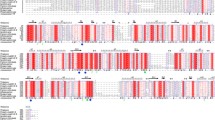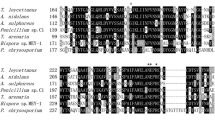Abstract
Using degenerate polymerase chain reaction (PCR) and thermal asymmetric interlaced PCR, a 1,347-bp full-length complementary DNA fragment encompassing the gene man5A, which encodes a 429-amino acid β-mannanase with a calculated mass of 46.8 kDa, was cloned from acidophilic Bispora sp. MEY-1. The deduced amino acid sequence (catalytic domain) displayed highest identity (54.1%) with the Emericella nidulans endo-β-1,4-d-mannanase, a member of the glycoside hydrolase family 5. Recombinant MAN5A was overexpressed in Pichia pastoris, and its activity in the culture medium reached 500 U ml−1. The enzyme was acidophilic, with highest activity at pH 1.0–1.5, lower than any known mannanases, and optimal temperature for activity was 65°C. MAN5A had good pH adaptability, excellent thermal and pH stability, and high resistance to both pepsin and trypsin. The specific activity, K m, and V max for locust bean gum substrate was 3,373 U mg−1, 1.56 mg ml−1, and 6,587.6 μmol min−1 mg−1, respectively. The enzymatic activity was not significantly affected by ions such as Ca2+, Cr3+, Co2+, Zn2+, Na+, K+, and Mg2+ and enhanced by Ni2+, Fe3+, Mn2+ and Ag+. These favorable properties make MAN5A a potential candidate for use in various industrial applications.


Similar content being viewed by others
References
Bradford MM (1976) A rapid and sensitive method for the quantitation of microgram quantities of protein utilizing the principle of protein-dye binding. Anal Biochem 72:248–254
Cereghino JL, Cregg JM (2000) Heterologous protein expression in the methylotrophic yeast Pichia pastoris. FEMS Microbiol Rev 24:45–66
Chen X, Cao Y, Ding Y, Lu W, Li D (2007a) Cloning, functional expression and characterization of Aspergillus sulphureus β-mannanase in Pichia pastoris. J Biotechnol 128:452–461
Chen X, Qiao Y, Ding H, Yue M (2007b) Expression of β-mannanase gene from Trichoderma reesei RUTC-30 in Pichia pastoris. J Agric Biotechnol 15:142–143 (in Chinese)
Christgau S, Kauppinen S, Vind J, Kofod LV, Dalbøge H (1994) Expression, cloning, purification and characterization of a β-1,4-mannanase from Aspergillus aculeatus. Biochem Mol Biol Int 33:917–925
Dhawan S, Kaur J (2007) Microbial mannanases: an overview of production and applications. Crit Rev Biotechnol 27:197–216
Fushinobu S, Ito K, Konno M, Wakagi T, Matsuzawa H (1998) Crystallographic and mutational analyses of an extremely acidophilic and acid-stable xylanase: biased distribution of acidic residues and importance of Asp37 for catalysis at low pH. Protein Eng 11:1121–1128
Gubitz GM, Hayn M, Urbanz G, Steiner W (1996) Purification and properties of an acidic β-mannanase from Sclerotium rolfsii. J Biotechnol 45:165–172
Henrissat B, Bairoch A (1993) New families in the classification of glycosyl hydrolases based on amino acid sequence similarities. Biochem J 293:781–788
Huang YW, Krauss G, Cottaz S, Driguez H, Lipps G (2005) A highly acid-stable and thermostable endo-β-glucanase from the thermoacidophilic archaeon Sulfolobus solfataricus. Biochem J 385:581–588
Laemmli UK (1970) Cleavage of structural proteins during the assembly of the head of bacteriophage T4. Nature 227:680–685
Larsson AM, Anderson L, Xu B, Muñoz IG, Usón I, Janson JC, Stålbrand H, Ståhlberg J (2006) Three-dimensional crystal structure and enzymatic characterization of β-mannanase Man5A from blue mussel Mytilus edulis. J Mol Biol 357:1500–1510
Liu YG, Whittier RF (1995) Thermal asymmetric interlaced PCR: automatable amplification and sequencing of insert end fragments from P1 and YAC clones for chromosome walking. Genomics 25:674–681
McCleary BV (1988) β-Mannanase. Methods Enzymol 160:596–610
Miller GL (1959) Use of dinitrosalicylic acid reagent for determination of reducing sugar. Anal Chem 31:426–428
Regalado C, Garcia-Almendarez BE, Venegas-Barrera LM, Tellez-Jurado A, Rodriguez-Serrano G, Huerta-Ochoa S, Whitaker JR (2000) Production, partial purification and properties of β-mannanases obtained by solid substrate fermentation of spent soluble coffee wastes and copra paste using Aspergillus oryzae and Aspergillus niger. J Sci Food Agric 80:1343–1350
Setati ME, Ademark P, van Zyl WH, Stålbrand H, Hahn-Hägerdal B (2001) Expression of the Aspergillus aculeatus endo-β-1,4-mannanase encoding gene (man1) in Saccharomyces cerevisiae and characterization of the recombinant enzyme. Protein Expr Purif 21:105–114
Sielecki AR, Fedorov AA, Boodhoo A, Andreeva NS, James MN (1990) Molecular and crystal structures of monoclinic porcine pepsin refined at 1.8Å resolution. J Mol Biol 214:143–170
Stålbrand H (2003) Enzymology of endo-β-1,4-mannanase. In: Whitaker JR, Voragen AJG, Wong DWS (eds) Handbook of food enzymology. Marcel Dekker, New York, pp 961–969
Stålbrand H, Siika-Aho M, Tenkanen M, Viikari L (1993) Purification and characterization of two β-mannanases from Trichoderma reesei. J Biotechnol 29:229–242
Stålbrand H, Saloheimo A, Vehmaanperä J, Henrissat B, Penttila M (1995) Cloning and expression in Saccharomyces cerevisiae of a Trichoderma reesei β-mannanase gene containing a cellulose binding domain. Appl Environ Microbiol 61:1090–1097
Tamaru Y, Araki T, Amagoi H, Mori H, Morishita T (1995) Purification and characterization of an extracellular β-1,4-mannanase from a marine bacterium, Vibrio sp. strain MA-138. Appl Environ Microbiol 61:4454–4458
Trimble RB, Lubowski C, Hauer CR, Stack R, McNaughton L, Gemmill TR, Kumar SA (2004) Characterization of N- and O-linked glycosylation of recombinant human bile salt-stimulated lipase secreted by Pichia pastoris. Glycobiology 14:265–274
Yang PL, Shi PJ, Wang YR, Bai YG, Meng K, Luo HY, Yuan TZ, Yao B (2007) Cloning and overexpression of a Paenibacillus β-glucanase in Pichia pastoris: purification and characterization of the recombinant enzyme. J Microbiol Biotechnol 17:58–66
Zakakaria MM, Yagi YT (1998) Purification and characterization of an endo-1,4-β-mannanase from Bacillus subtilis KU-1. FEMS Microbiol Lett 158:25–31
Zhu J, Wu MC (2007) Studies on the characterization of acidic β-mannanase from Aspergillus niger. J Food Biotechnol 26:21–25 (in Chinese)
Acknowledgments
This research was supported by the National High Technology Research and Development Program of China (863 program, Grant no. 2007AA100601), Chinese Program on Research for Public Good (Grant No. 2005DIB4J038), and 948 program of the Ministry of Agriculture (Grant No. 2007-Z3)
Author information
Authors and Affiliations
Corresponding author
Rights and permissions
About this article
Cite this article
Luo, H., Wang, Y., Wang, H. et al. A novel highly acidic β-mannanase from the acidophilic fungus Bispora sp. MEY-1: gene cloning and overexpression in Pichia pastoris . Appl Microbiol Biotechnol 82, 453–461 (2009). https://doi.org/10.1007/s00253-008-1766-x
Received:
Revised:
Accepted:
Published:
Issue Date:
DOI: https://doi.org/10.1007/s00253-008-1766-x




